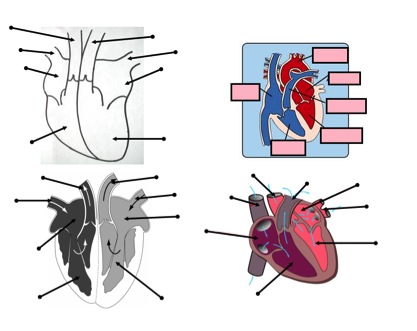Heart and circulatory system teaching resources
Worksheets and lesson ideas to challenge students aged 11 to 16 to think hard about the heart, blood and the circulatory system (GCSE and Key Stage 3)
Key concept: blood moves from higher pressure to lower pressure through the circulatory system and transports reactants and products of respiration, products of digestion, hormones and white blood cells around the body. The structure of blood vessels and the heart are related to their function.
From big idea: Organisms are organised on a cellular basis and have a finite life span
Linked knowledge: pressure, particles, solutions, respiration, breathing, specialised cells, kidney
Misconception [scientific idea]: blood is made in the heart [blood is made in the bone marrow]; blood is a cell [blood is a tissue]; blood flows slowly through the capillaries because of their narrow lumen [blood flow rate is lowest at the capillary network because of its large total cross-sectional area (1000 x that of the aorta].
Teaching resources
Where to start?
I think it is helpful to begin with the components and function of blood – the stuff that you are transporting. Get a jug – fill it with water (plasma). Now add in some white blood cells (polystyrene), red blood cells (Cheerios stained with red dye) and platelets (plasters). Take this blood to the ‘stomach’ – add in some salts (NaCl) and glucose (sugar). You could also add in amino acids (glitter) and lipids (oil) too. Add in some urea (yellow balls) from Liver. Blow into the mixture some oxygen. Give it a good stir. Now how do we get these substances to the cells in our foot? What waste substances will now be added (carbon dioxide).
Components of blood
GCSE and Key Stage 3 worksheet looking at the different components of blood. The worksheet starts by assessing prior knowledge with students having to list what substances are present in blood. We then look at a sample of blood after centrifugation and students list what substances and cells are present in each fraction. Finally we think about how blood from different people may vary. (PDF)
Adaptations of veins, arteries and capillaries
GCSE worksheet on adaptations of veins, capillaries and arteries. Students use different tubes to help them understand how veins, capillaries and arteries are adapted for their function. This activity is designed so that students have a overall understanding of blood flow first and how this links to respiration. (PDF)
Heart structure
GCSE worksheet on labelling heart structure. Students label four diagrams of the heart and evaluate the models from the perspectives of different individuals. This activity offers a more challenging way to introduce what can be quite a low-level task of labelling a heart. This resource was made in collaboration with Thomas Kitwood. (PDF)
Relating structure to function in the circulatory system
GCSE writing task relating the structure to function of blood vessels and the heart.This activity explores students’ understanding of the circulatory system through the context of giraffes. The unfamiliar context requires students to really understand the function of vessels and the heart to answer this question and so provides a great setting to provide feedback.The process of writing also provides an opportunity for students to structure and reorganise their own ideas to construct a deeper meaning. (PDF)
Thinking deeper
- What are the advantages and disadvantages of an organism having small red blood cells as opposed to larger ones?
- Why don’t bacteria have a transport system?
- What are the minimum requirements of a transport system?
- Fish have a single circulatory system. Mammals have a double circulatory system. What are the advantages of a double circulatory system?
Further reading
- Yip, D. (1998). Teachers’ misconceptions of the circulatory system. Journal of Biological Education, 32. 207-215.

